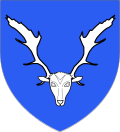Earls of Dartmouth
William was succeeded by his grandson, the second Earl. He was the only surviving son of George Legge, Viscount Lewisham (d. 1732), eldest son of the first Earl, who had died before his father. He was also an influential politician and served as Secretary of State for the Colonies and First Lord of Trade between 1772 and 1775. The American Ivy League school Dartmouth College in Hanover, New Hampshire, was named for the second Earl by Congregational minister Eleazar Wheelock.
The second earl's eldest son, the third Earl, was summoned to the House of Lords through a writ of acceleration as Baron Dartmouth in June 1801. Soon after, in July 1801, he succeeded his father in the earldom. Lord Dartmouth held office as President of the Board of Control between 1801 and 1802. On his death, the titles passed to his eldest son, the fourth Earl, who had briefly represented Milborne Port in Parliament before succeeding in the earldom.
The fourth earl's only surviving child from his first marriage, the fifth Earl, was a Conservative politician and also served as Lord Lieutenant of Staffordshire. His eldest son, the sixth Earl, was also a Conservative politician and served twice as Vice-Chamberlain of the Household.
The latter was succeeded by his eldest son, the seventh Earl, who married Lady Ruperta, daughter of the 1st Marquess of Lincolnshire. Lady Ruperta inherited a share of the office of Lord Great Chamberlain from her father, and after his father-in-law's death in 1928, Lord Dartmouth acted as Deputy Lord Great Chamberlain until the death of George V in 1936.
The seventh earl's only son, William Legge, Viscount Lewisham, was killed at El Alamein in 1942, and Dartmouth was consequently succeeded by his younger brother, Humphry, the eight Earl.
As of 2018, the titles are held by Humphry's grandson, the tenth Earl, who succeeded his father in 1997. Lord Dartmouth was a Member of the European Parliament for the UK Independence Party between 2009 and 2019, but left the party in 2018, becoming an independent member.
Other family members
Several other members of the Legge family have also gained distinction. The Hon. Henry Bilson-Legge, fourth son of the first Earl, was a politician and served three times as Chancellor of the Exchequer. Sir Arthur Kaye Legge, sixth son of the second Earl, was an admiral in the Royal Navy. The Hon. Edward Legge, seventh son of the second Earl, was Bishop of Oxford. The Hon. Heneage Legge, second son of the third Earl, sat as Member of Parliament for Banbury. Arthur Legge, fourth son of the third Earl, was a general in the British Army and Member of Parliament for Banbury. The Hon. Augustus Legge, fifth son of the fourth Earl, was Bishop of Lichfield. The Hon. Heneage Legge, sixth son of the fourth Earl, was Member of Parliament for St George's Hanover Square.


